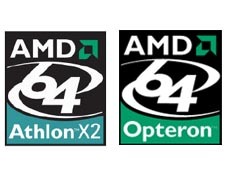AMD launches dual-core Opteron, announces X2 brand for desktop dual-core
Sunnyvale (CA) - AMD today officially introduced its first dual-core processor. Heading up the launch is the Opteron 800-series for servers. The 200-series for workstations will follow in May, the Athlon X2 targeting desktops is expected to make its debut in June.
Technically, AMD lost the dual-core race with Intel by four days, as its competitor launched the Pentium 4 Extreme Edition on Monday this week. Realistically, AMD is first to the market with a broad range of processors that is targeting the corporate and enterprise market and the outlook of a desktop dual-core as Pentium D rival following in less than two months.
At launch, AMD offers the 800-series for 4-way and 8-way servers as models 865 (1.8 GHz), 870 (2.0 GHz), and 875 (2.2 GHz). The company will add in May the corresponding 2-way workstation and server chips 265 (1.8 GHz), 270 (2.0 GHz), and 275 (2.2 GHz). While frequencies and the naming of these chips have been rumored for quite some time on various, the big news from AMD today is the unveiling of the desktop processor. The manufacturer confirmed the X2 brand for the dual-core desktop chip, which will hit the market in June.
While it is obvious that AMD accelerated the development X2 to match Intel with the availability of the Pentium D as close as possible, the manufacturer follows through with its strategy to make dual-cores available first for corporate and enterprise customers. According to an AMD spokesperson, this segment will be able to take advantage first of dual-cores since the industry has been working with 2- to 8-way systems for some time now and has access to multi-threaded applications. "If you buy a dual-core client, you really have to understand what you buy," the spokesperson said. Both AMD and Intel agree that dual-core desktop chips are unlikely to offer faster performance in all user scenarios but rather represent an investment in the future by allowing performance increases in multitasking as well as upcoming multithreaded applications. In contrast to the consumer-space, AMD believes that dual-cores are a "straight-forward innovation for the enterprise."
AMD's and Intel's strategies however do not only differ in the roll-out of products, but also in the implementation of the new chips. Intel dual-cores come with a slightly changed pin number, AMD chose to stay with its current 939-pin package for the X2 and 940 for the Opteron - allowing customers to simply exchange processors in existing boards for a smooth transition without disruptive effects. This strategy fits into previous successful approaches - such as a smooth transition to 64-bit and support 32-bit at the same time.
As announced during a recent phone conference discussing first quarter financial results, AMD will take advantage of its dual-core offering by pricing the processors at the very high end of its lineup. The 865 chip is priced at $1514, the 870 at $2149 and the 875 at $2649 - translating into price premiums between 170 and more than 320 percent compared to the respective single-cores. The 200 series will be available from $851 to $1299 with premiums ranging between 200 and more than 400 percent. Corresponding 1-way Opterons 165, 170 and 175 are indicated in AMD's Opteron spec sheets, pricing however has not been announced yet.
The X2 processor will be offered at similarly high price levels with the top model 4800+ breaking the $1000 mark ($1001). The 4600+ will cost $803, the 4400+ $581, and the 4200+ $537. The currently fastest single-core Athlon (4000+) is priced at $643, the high-end FX-55 at $827.
Get Tom's Hardware's best news and in-depth reviews, straight to your inbox.

Wolfgang Gruener is an experienced professional in digital strategy and content, specializing in web strategy, content architecture, user experience, and applying AI in content operations within the insurtech industry. His previous roles include Director, Digital Strategy and Content Experience at American Eagle, Managing Editor at TG Daily, and contributing to publications like Tom's Guide and Tom's Hardware.
